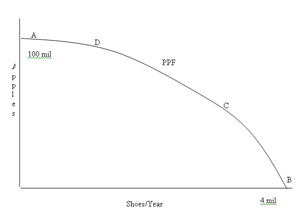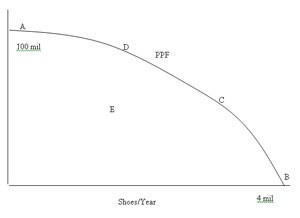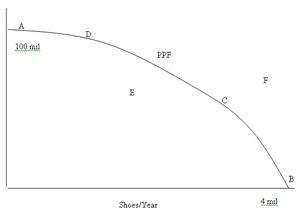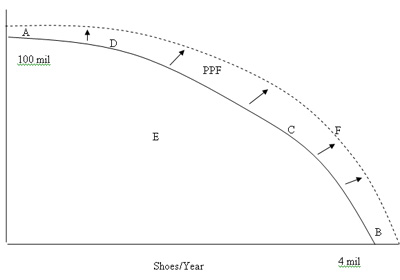Should I go to work today? Should I go to college after high school? Should the government spend money on a new weapon system? These are decisions that are made everyday; however, what is the cost of our decisions? What is the cost of going to work, or the decision not to go to work? What is the cost of college, or not to go to college? Finally what is the cost of buying that weapon system, or the cost of not buying that weapon? In economics it is called opportunity cost.
 Opportunity cost is the cost we pay when we give up something to get something else. There can be many alternatives that we give up to get something else, but the opportunity cost of a decision is the most desirable alternative we give up to get what we want.
Opportunity cost is the cost we pay when we give up something to get something else. There can be many alternatives that we give up to get something else, but the opportunity cost of a decision is the most desirable alternative we give up to get what we want.
Let’s look at our examples from above. If you have a job, what do you give up to go to work? There are many possibilities. I could sleep in. If it is a nice day I could take my dog to the park and play all day. Or, I could even spend the day looking for a better job right? I give up all of these things if I choose to go to work. What I get from working is a greater benefit than the cost of giving up these things. But, opportunity cost is the most desirable thing given up not the aggregate of the things we gave up.
Let’s look at the college example. We are all told to go to college so you can get a good education and that will translate into a good job. How do we know that college is such a good thing? How much college do we need? Let’s look at some numbers from a study on education from the Institute of Government and Public Affairs:
There are distinct benefits of a college education. A study conducted by the Institute of Government and Public Affairs for the Illinois Board of Higher Education, showed the following benefits:
- Higher Earnings – Earning a bachelor’s degree provides the average student with over $590,000 in future earnings. Similarly a professional degree provides a present value to the student of almost $1.25 million in future earnings.
- Labor force participation rates and employment rates for people aged 25 and over increase with increased levels of education.
- People with college experience contribute time and money to charitable causes at a higher rate than those with less education.
- Increased levels of education are associated with the increased likelihood of voting or registering to vote.
“In addition, college can provide many other benefits that are less tangible, and will help your child become a better-rounded individual. Benefits include increased self-awareness, the ability to think critically, and an opportunity to meet many different people. Overall, the entire college experience will provide your child with a lifetime of benefits”.
As we can see there are many benefits to a college education. So what are the costs? There are monetary costs for sure. Also, we will spend four or more years going to classes. We could be working and earning money instead of going to college. Finally we will be giving up free time for study time that could be used to do other things.
What about spending money on a missile defense system? In the fiscal year 2006 budget the taxpayers of Colorado will spend, as a fraction of overall federal spending, $150.7 million for the ballistic missile defense system (Center on Arms Control and Nuclear Proliferation). That same money could pay for 27,547 people to get health care (Centers for Medicare and Medicaid Data Compendium) or, 37,384 scholarships for university students (National Center for Education Statistics). These represent real choices that the government must make with our Tax dollars. The opportunity costs in this case depend upon what you value more military spending, health care, or college scholarships.
To get a graphical representation of how an economy makes decisions on what to produce, or spend their money on, we will use a Production Possibilities Curve.
Production Possibilities Curve shows the choices a country can make with respect to its available resources.
Resources are Land, Labor, and Capital
Land– this refers to all natural resources used to produce goods and services. This includes crops that are grown on a land, minerals that are mined from land and rent that is paid to an owner of land for its use.
Goods and services are the things that we buy like mp3 players or hair cuts. A good is a physical thing you can hold a service is some thing that gets used up right after it is purchased.
Labor– this is the effort that an individual person puts into making a good or service. This for this effort the person is paid a wage. Labor includes factory workers, medical personal, and teachers. They all provide their labor for a wage.
Capital– this is anything that is used to produce other goods and services. If you make cars you need machines to make the metal that is used in the cars. It is also the truck that drives the cars to the dealer who sells them, and it is the building that the cars are made in. All of these are the resource known as capital.
If we look at a simple model of an economy for the country of Appleoplios it shows that they can produce two goods apples and shoes, we can get a better idea of what choices they have for production. When the resources of Appleoplios are used to their full potential they can produce 100 million apples (point A) a year or they can produce 4 million pairs of shoes (point B), but they cannot produce all of both.

The line that connects points A and B is called a production possibilities frontier (PPF). It represents all of the possible combinations of production possibilities available to Appleoplios. If the economy decides that it needs apples and shoes it can choose to produce at any point along the production possibilities curve. If they choose to produce at point C they are making a combination of let’s say shoes 3.5 million shoes and 50 million apples. With that in mind, what is the opportunity cost of producing 3.5 million shoes? What did we give up to produce the shoes? We gave up 50 million apples. Opportunity cost is always expressed in terms of what we gave up in order to get something else. In this case we gave up 50 million apples so we could move some resources in to the production of shoes.
What about point D on the curve? At point D Appleoplios can produce 80 million apples and 2 million shoes. What is the opportunity cost in terms of shoes? How many shoes did they give up in order to make 80 million apples? They gave up 2 million shoes. So using all the available resources the country of Appleoplios has a variety of production choices. When the produce on the production possibilities curve they are using all of their resources to there maximum potential. This is their most efficient point.

What about some other possible points for consideration? Can they, for example produce at point E? Yes they can. This is a point of under utilization of resources. They are not operating at peak efficiency. Why would thy do this? If Appleoplios wants to save some resource for future use then they would produce at a point inside their PPF. Maybe they want to save water or another resource to use at a later date.

What about point F? Can Appleoplios produce at point F? Not at this time. They do not have enough resources to produce at this point. Would the country like to produce at point F? Sure they would, but how do they do it? They need to fine more resources or use technology to increase their production possibilities. Like all economies they want to produce more then the year before. They want to move their production possibilities curve out to point F and further the next year.

This is a new PPF that is achieved with the introduction of new resources or a new technology that can help the production process.
For a teaching lesson plan for this lesson see:
Economics Opportunity Cost Lesson Plan
Excellent.